 Vol.3, No.3, 254-264 (2013) Open Journal of Ecology http://dx.doi.org/10.4236/oje.2013.33029 Anthropozoic impact on the floristic biodiversity in the area of Beni Saf (Algeria) Sidi Mohammed Merioua1*, Abdelhakim Seladji2, Noury Benabadji3 1University Center of Tissemsilt, Tissemsilt, Algeria; *Corresponding Author: sm.merioua@gmail.com 2National Institute of Forestry Research Station of Tlemcen, Tlemcen, Algeria 3University of Tlemcen, Tlemcen, Algeria Received 9 April 2013; revised 22 May 2013; accepted 27 June 2013 Copyright © 2013 Sidi Mohammed Merioua et al. This is an open access article distributed under the Creative Commons Attribution License, which permits unrestricted use, distribution, and reproduction in any medium, provided the original work is properly cited. ABSTRACT The degradation of the natural resources in Al- geria nowadays remains a major constraint for the agrosilvopastoral development. Indeed, the area of Beni Saf is confronted with many prob- lems such as the anthropozoic pressure which does not make it possible to keep balance be- tween the exploitation of the natural resources and their regenerations in time and space. Fol- lowing the example results obtained through a floristic study by the factorial analysis of corre- spondences (F A C), concerning the identifica- tion of anthropozoogenes species suc h a s: Cha- maerops humilis, Asphodelus microcarpus, With- ania frutescens, Calycotome spinosa, Asparagus albus; furthermore, the calculation of the dis- turbance index which marks the rate of thero- phytisation which is about 68%, that one finds it very high. These indices show a disturbance and an imbalance of the plant formation of the zone of study, caused by the high anthropozoogene pressure. Vis-a-vis this threat, it is essential to propose a possibility of intervention for a dura- ble management of these spaces. Keywords: Biodiversity; Geographical Information System; Factorial Analysis of Correspondences; Anthropozoïc Impact; Beni Saf (Algeria) 1. INTRODUCTION In the Mediterranean region, the multiple paleogeo- graphic events and the contrasted climatic cycles also allowed the emergence of this unusually high biodiver- sity [1]. In the South and the East of the Mediterranean, the ecosystems are always intensively used by the man. Because of the considerable population growth, there has been acceleration during the three last decades of the use of the natural resources which often exceeds their ca- pacities of renewal [2]. The north of Algeria is subject to strong pressures of men and cattle that generated a severe impoverishment of the soil and vegetable cover [3]. The anthropozoïc fac- tors play a major role in the organization of the vegeta- tion structures. Indeed, the population growth rate, espe- cially rural, determined a radical transformation of the use of the environment. Deforestation, dematorralisation, anarchic cuts, uncontrolled cultures’ settings and exces- sive overgrazing, deeply disturbed ecological balances which existed twenty years ago [4]. In Algeria, especially in Beni Saf, the anthropisation is remarkable. We notice several causes of deforestation which come into play: the conversion of forest surfaces to the profit of other destinations in particular, of the pas- ture and the field crops. In addition to the demographic pressure which is increasingly important, this is primar- ily related to the migrations, leading to the reduction of forest spaces, and disturbing the ecosystems. The objective of this work is to determine the impact of the anthropozoic actions on the floristic biodiversity in order to highlight the possibilities of intervention for a better management of this weakened ecosystem. 2. MATERIALS AND METHODS 2.1. Materials 2.1.1. State of the Vegetable Formations The zone of study covers an area of 6 162 Ha. It is lo- cated at the level of the commune of BeniSaf on the North-western littoral of Algeria (Figure 1). The com- mune’s population is estimated at approximately 43 802 inhabitants and an average density of 715 per/km2. Most of it, approximately 80%, concentrates in the town of Beni Saf. The active population (between 20 and 64 years old) of the commune lives mainly on agriculture. Copyright © 2013 SciRes. OPEN A CCESS 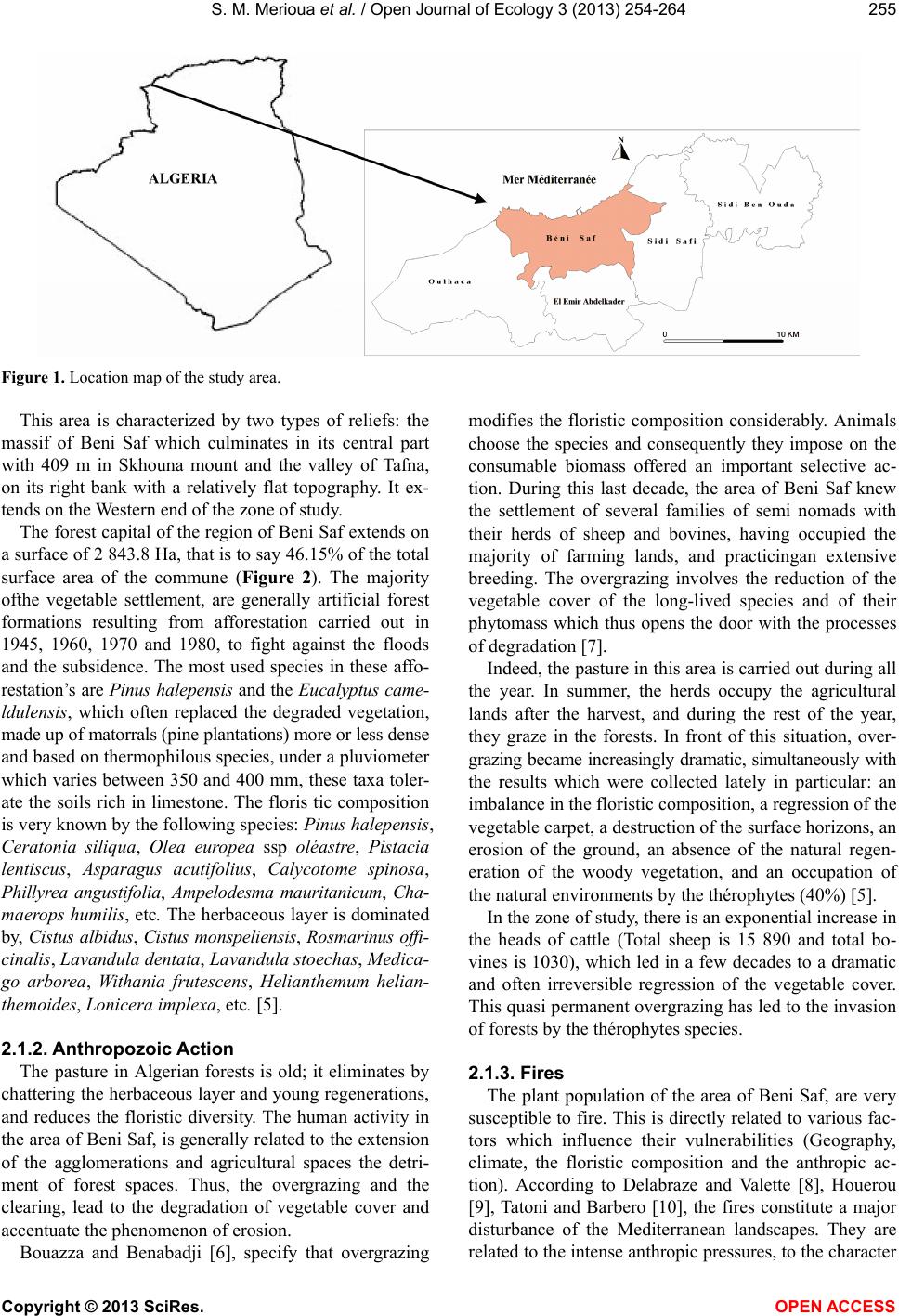 S. M. Merioua et al. / Open Journal of Ecology 3 (2013) 254-264 255 Figure 1. Location map of the study area. This area is characterized by two types of reliefs: the massif of Beni Saf which culminates in its central part with 409 m in Skhouna mount and the valley of Tafna, on its right bank with a relatively flat topography. It ex- tends on the Western end of the zone of study. The forest capital of the region of Beni Saf extends on a surface of 2 843.8 Ha, that is to say 46.15% of the total surface area of the commune (Figure 2). The majority ofthe vegetable settlement, are generally artificial forest formations resulting from afforestation carried out in 1945, 1960, 1970 and 1980, to fight against the floods and the subsidence. The most used species in these affo- restation’s are Pinus halepensis and the Eucalyptus came- ldulensis, which often replaced the degraded vegetation, made up of matorrals (pine plantations) more or less dense and based on thermophilous species, under a pluviometer which varies between 350 and 400 mm, these taxa toler- ate the soils rich in limestone. The floris tic composition is very known by the following species: Pinus halepensis, Ceratonia siliqua, Olea europea ssp oléastre, Pistacia lentiscus, Asparagus acutifolius, Calycotome spinosa, Phillyrea angustifolia, Ampelodesma mauritanicum, Cha- maerops humilis, etc. The herbaceous layer is dominated by, Cistus albidus, Cistus monspeliensis, Rosmarinus offi- cinalis, Lavandula dentata, Lavandula stoechas, Medica- go arborea, Withania frutescens, Helianthemum helian- themoides, Lonicera implexa, etc. [5]. 2.1.2. Anthro pozoic Actio n The pasture in Algerian forests is old; it eliminates by chattering the herbaceous layer and young regenerations, and reduces the floristic diversity. The human activity in the area of Beni Saf, is generally related to the extension of the agglomerations and agricultural spaces the detri- ment of forest spaces. Thus, the overgrazing and the clearing, lead to the degradation of vegetable cover and accentuate the phenomenon of erosion. Bouazza and Benabadji [6], specify that overgrazing modifies the floristic composition considerably. Animals choose the species and consequently they impose on the consumable biomass offered an important selective ac- tion. During this last decade, the area of Beni Saf knew the settlement of several families of semi nomads with their herds of sheep and bovines, having occupied the majority of farming lands, and practicingan extensive breeding. The overgrazing involves the reduction of the vegetable cover of the long-lived species and of their phytomass which thus opens the door with the processes of degradation [7]. Indeed, the pasture in this area is carried out during all the year. In summer, the herds occupy the agricultural lands after the harvest, and during the rest of the year, they graze in the forests. In front of this situation, over- grazing became increasingly dramatic, simultaneously with the results which were collected lately in particular: an imbalance in the floristic composition, a regression of the vegetable carpet, a destruction of the surface horizons, an erosion of the ground, an absence of the natural regen- eration of the woody vegetation, and an occupation of the natural environments by the thérophytes (40%) [5]. In the zone of study, there is an exponential increase in the heads of cattle (Total sheep is 15 890 and total bo- vines is 1030), which led in a few decades to a dramatic and often irreversible regression of the vegetable cover. This quasi permanent overgrazing has led to the invasion of forests by the thérophytes species. 2.1.3. Fires The plant population of the area of Beni Saf, are very susceptible to fire. This is directly related to various fac- tors which influence their vulnerabilities (Geography, climate, the floristic composition and the anthropic ac- tion). According to Delabraze and Valette [8], Houerou [9], Tatoni and Barbero [10], the fires constitute a major disturbance of the Mediterranean landscapes. They are related to the intense anthropic pressures, to the character Copyright © 2013 SciRes. OPEN A CCESS 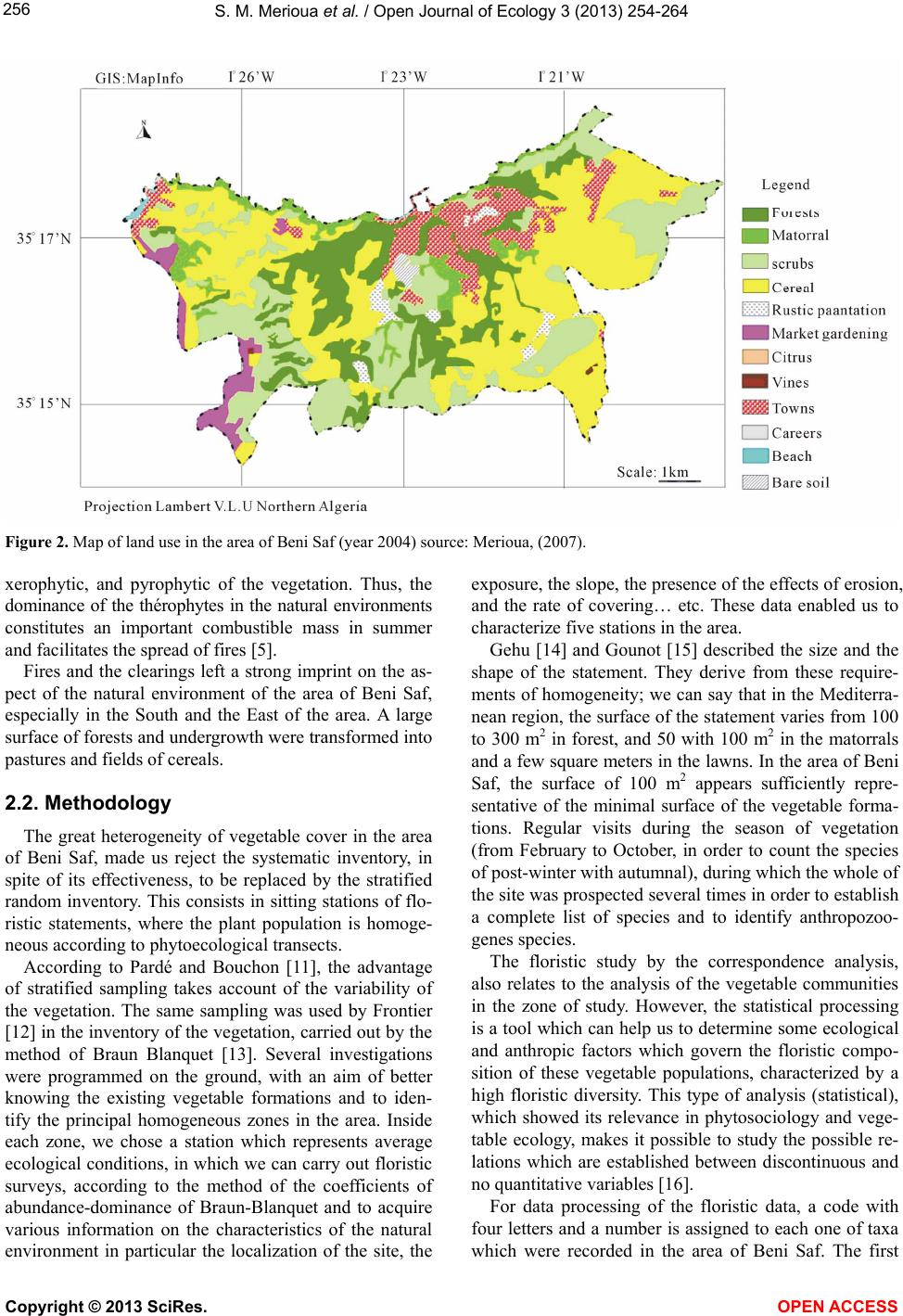 S. M. Merioua et al. / Open Journal of Ecology 3 (2013) 254-264 256 Figure 2. Map of land use in the area of Beni Saf (year 2004) source: Merioua, (2007). xerophytic, and pyrophytic of the vegetation. Thus, the dominance of the thérophytes in the natural environments constitutes an important combustible mass in summer and facilitates the spread of fires [5]. Fires and the clearings left a strong imprint on the as- pect of the natural environment of the area of Beni Saf, especially in the South and the East of the area. A large surface of forests and undergrowth were transformed into pastures and fields of cereals. 2.2. Methodology The great heterogeneity of vegetable cover in the area of Beni Saf, made us reject the systematic inventory, in spite of its effectiveness, to be replaced by the stratified random inventory. This consists in sitting stations of flo- ristic statements, where the plant population is homoge- neous according to phytoecological transects. According to Pardé and Bouchon [11], the advantage of stratified sampling takes account of the variability of the vegetation. The same sampling was used by Frontier [12] in the inventory of the vegetation, carried out by the method of Braun Blanquet [13]. Several investigations were programmed on the ground, with an aim of better knowing the existing vegetable formations and to iden- tify the principal homogeneous zones in the area. Inside each zone, we chose a station which represents average ecological conditions, in which we can carry out floristic surveys, according to the method of the coefficients of abundance-dominance of Braun-Blanquet and to acquire various information on the characteristics of the natural environment in particular the localization of the site, the exposure, the slope, the presence of the effects of erosion, and the rate of covering… etc. These data enabled us to characterize five stations in the area. Gehu [14] and Gounot [15] described the size and the shape of the statement. They derive from these require- ments of homogeneity; we can say that in the Mediterra- nean region, the surface of the statement varies from 100 to 300 m2 in forest, and 50 with 100 m2 in the matorrals and a few square meters in the lawns. In the area of Beni Saf, the surface of 100 m2 appears sufficiently repre- sentative of the minimal surface of the vegetable forma- tions. Regular visits during the season of vegetation (from February to October, in order to count the species of post-winter with autumnal), during which the whole of the site was prospected several times in order to establish a complete list of species and to identify anthropozoo- genes species. The floristic study by the correspondence analysis, also relates to the analysis of the vegetable communities in the zone of study. However, the statistical processing is a tool which can help us to determine some ecological and anthropic factors which govern the floristic compo- sition of these vegetable populations, characterized by a high floristic diversity. This type of analysis (statistical), which showed its relevance in phytosociology and vege- table ecology, makes it possible to study the possible re- lations which are established between discontinuous and no quantitative variables [16]. For data processing of the floristic data, a code with four letters and a number is assigned to each one of taxa which were recorded in the area of Beni Saf. The first Copyright © 2013 SciRes. OPEN A CCESS 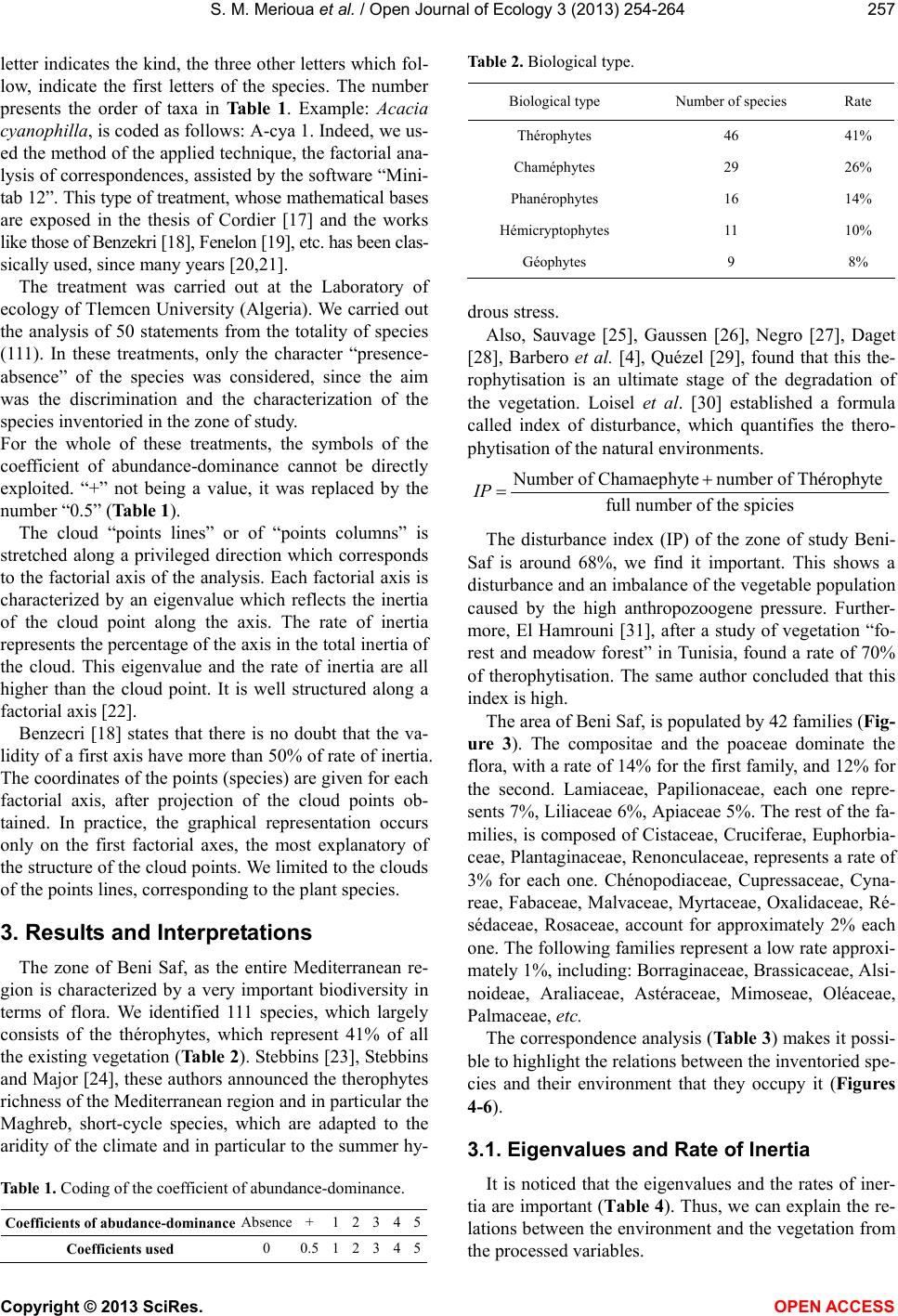 S. M. Merioua et al. / Open Journal of Ecology 3 (2013) 254-264 257 letter indicates the kind, the three other letters which fol- low, indicate the first letters of the species. The number presents the order of taxa in Table 1. Example: Acacia cyanophilla, is coded as follows: A-cya 1. Indeed, we us- ed the method of the applied technique, the factorial ana- lysis of correspondences, assisted by the software “Mini- tab 12”. This type of treatment, whose mathematical bases are exposed in the thesis of Cordier [17] and the works like those of Benzekri [18], Fenelon [19], etc. has been clas- sically used, since many years [20,21]. The treatment was carried out at the Laboratory of ecology of Tlemcen University (Algeria). We carried out the analysis of 50 statements from the totality of species (111). In these treatments, only the character “presence- absence” of the species was considered, since the aim was the discrimination and the characterization of the species inventoried in the zone of study. For the whole of these treatments, the symbols of the coefficient of abundance-dominance cannot be directly exploited. “+” not being a value, it was replaced by the number “0.5” (Table 1). The cloud “points lines” or of “points columns” is stretched along a privileged direction which corresponds to the factorial axis of the analysis. Each factorial axis is characterized by an eigenvalue which reflects the inertia of the cloud point along the axis. The rate of inertia represents the percentage of the axis in the total inertia of the cloud. This eigenvalue and the rate of inertia are all higher than the cloud point. It is well structured along a factorial axis [22]. Benzecri [18] states that there is no doubt that the va- lidity of a first axis have more than 50% of rate of inertia. The coordinates of the points (species) are given for each factorial axis, after projection of the cloud points ob- tained. In practice, the graphical representation occurs only on the first factorial axes, the most explanatory of the structure of the cloud points. We limited to the clouds of the points lines, corresponding to the plant species. 3. Results and Interpretations The zone of Beni Saf, as the entire Mediterranean re- gion is characterized by a very important biodiversity in terms of flora. We identified 111 species, which largely consists of the thérophytes, which represent 41% of all the existing vegetation (Table 2). Stebbins [23], Stebbins and Major [24], these authors announced the therophytes richness of the Mediterranean region and in particular the Maghreb, short-cycle species, which are adapted to the aridity of the climate and in particular to the summer hy- Table 1. Coding of the coefficient of abundance-dominance. Coefficients of abudance-dominanceAbsence + 1 2345 Coefficients used 0 0.5 1 2345 Table 2. Biological type. Biological type Number of species Rate Thérophytes 46 41% Chaméphytes 29 26% Phanérophytes 16 14% Hémicryptophytes 11 10% Géophytes 9 8% drous stress. Also, Sauvage [25], Gaussen [26], Negro [27], Daget [28], Barbero et al. [4], Quézel [29], found that this the- rophytisation is an ultimate stage of the degradation of the vegetation. Loisel et al. [30] established a formula called index of disturbance, which quantifies the thero- phytisation of the natural environments. umber of Chamaephytenumber of Throphyte full number of the spicies IP é The disturbance index (IP) of the zone of study Beni- Saf is around 68%, we find it important. This shows a disturbance and an imbalance of the vegetable population caused by the high anthropozoogene pressure. Further- more, El Hamrouni [31], after a study of vegetation “fo- rest and meadow forest” in Tunisia, found a rate of 70% of therophytisation. The same author concluded that this index is high. The area of Beni Saf, is populated by 42 families (Fig- ure 3). The compositae and the poaceae dominate the flora, with a rate of 14% for the first family, and 12% for the second. Lamiaceae, Papilionaceae, each one repre- sents 7%, Liliaceae 6%, Apiaceae 5%. The rest of the fa- milies, is composed of Cistaceae, Cruciferae, Euphorbia- ceae, Plantaginaceae, Renonculaceae, represents a rate of 3% for each one. Chénopodiaceae, Cupressaceae, Cyna- reae, Fabaceae, Malvaceae, Myrtaceae, Oxalidaceae, Ré- sédaceae, Rosaceae, account for approximately 2% each one. The following families represent a low rate approxi- mately 1%, including: Borraginaceae, Brassicaceae, Alsi- noideae, Araliaceae, Astéraceae, Mimoseae, Oléaceae, Palmaceae, etc. The correspondence analysis (Table 3) makes it possi- ble to highlight the relations between the inventoried spe- cies and their environment that they occupy it (Figures 4-6). 3.1. Eigenvalues and Rate of Inertia It is noticed that the eigenvalues and the rates of iner- tia are important (Table 4). Thus, we can explain the re- lations between the environment and the vegetation from the processed variables. Copyright © 2013 SciRes. OPEN A CCESS  S. M. Merioua et al. / Open Journal of Ecology 3 (2013) 254-264 Copyright © 2013 SciRes. 258 Figure 3. Composition floristique par famille. Figure 4. Factorial plan of the species (axis 1 - axis 2). OPEN A CCESS  S. M. Merioua et al. / Open Journal of Ecology 3 (2013) 254-264 259 Figure 5. Factorial plan of the species (axis 1 - axis 3). Figure 6. Factorial plan of the species (axis 2 - axis 3). Copyright © 2013 SciRes. OPEN A CCESS 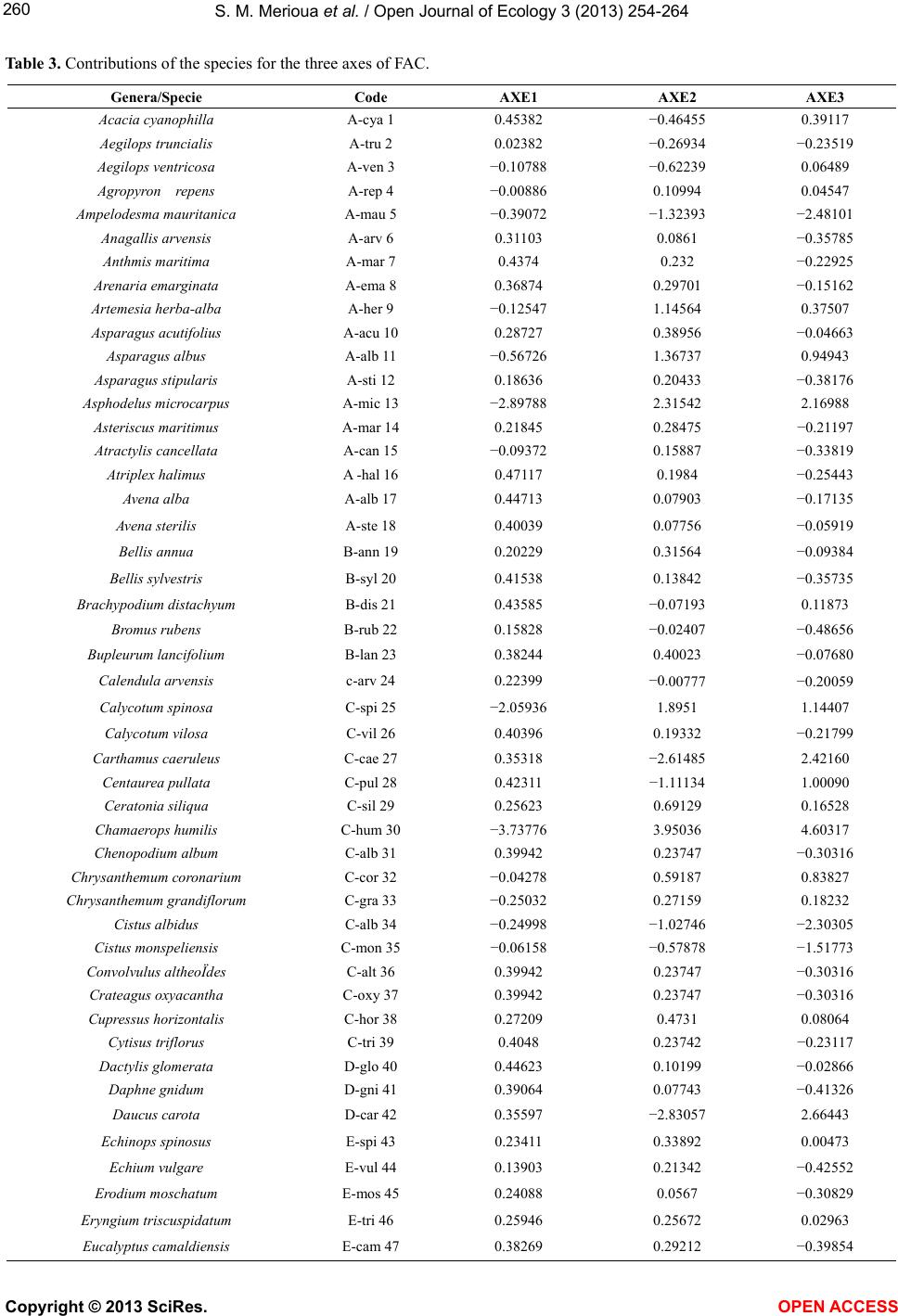 S. M. Merioua et al. / Open Journal of Ecology 3 (2013) 254-264 260 Table 3. Contributions of the species for the three axes of FAC. Genera/Specie Code AXE1 AXE2 AXE3 Acacia cyanophilla A-cya 1 0.45382 −0.46455 0.39117 Aegilops truncialis A-tru 2 0.02382 −0.26934 −0.23519 Aegilops ventricosa A-ven 3 −0.10788 −0.62239 0.06489 Agropyron repens A-rep 4 −0.00886 0.10994 0.04547 Ampelodesma mauritanica A-mau 5 −0.39072 −1.32393 −2.48101 Anagallis arvensis A-arv 6 0.31103 0.0861 −0.35785 Anthmis maritima A-mar 7 0.4374 0.232 −0.22925 Arenaria emarginata A-ema 8 0.36874 0.29701 −0.15162 Artemesia herba-alba A-her 9 −0.12547 1.14564 0.37507 Asparagus acutifolius A-acu 10 0.28727 0.38956 −0.04663 Asparagus albus A-alb 11 −0.56726 1.36737 0.94943 Asparagus stipularis A-sti 12 0.18636 0.20433 −0.38176 Asphodelus microcarpus A-mic 13 −2.89788 2.31542 2.16988 Asteriscus maritimus A-mar 14 0.21845 0.28475 −0.21197 Atractylis cancellata A-can 15 −0.09372 0.15887 −0.33819 Atriplex halimus A -hal 16 0.47117 0.1984 −0.25443 Avena alba A-alb 17 0.44713 0.07903 −0.17135 Avena sterilis A-ste 18 0.40039 0.07756 −0.05919 Bellis annua B-ann 19 0.20229 0.31564 −0.09384 Bellis sylvestris B-syl 20 0.41538 0.13842 −0.35735 Brachypodium distachyum B-dis 21 0.43585 −0.07193 0.11873 Bromus rubens B-rub 22 0.15828 −0.02407 −0.48656 Bupleurum lancifolium B-lan 23 0.38244 0.40023 −0.07680 Calendula arvensis c-arv 24 0.22399 −0.00777 −0.20059 Calycotum spinosa C-spi 25 −2.05936 1.8951 1.14407 Calycotum vilosa C-vil 26 0.40396 0.19332 −0.21799 Carthamus caeruleus C-cae 27 0.35318 −2.61485 2.42160 Centaurea pullata C-pul 28 0.42311 −1.11134 1.00090 Ceratonia siliqua C-sil 29 0.25623 0.69129 0.16528 Chamaerops humilis C-hum 30 −3.73776 3.95036 4.60317 Chenopodium album C-alb 31 0.39942 0.23747 −0.30316 Chrysanthemum coronarium C-cor 32 −0.04278 0.59187 0.83827 Chrysanthemum grandiflorum C-gra 33 −0.25032 0.27159 0.18232 Cistus albidus C-alb 34 −0.24998 −1.02746 −2.30305 Cistus monspeliensis C-mon 35 −0.06158 −0.57878 −1.51773 Convolvulus altheoÏdes C-alt 36 0.39942 0.23747 −0.30316 Crateagus oxyacantha C-oxy 37 0.39942 0.23747 −0.30316 Cupressus horizontalis C-hor 38 0.27209 0.4731 0.08064 Cytisus triflorus C-tri 39 0.4048 0.23742 −0.23117 Dactylis glomerata D-glo 40 0.44623 0.10199 −0.02866 Daphne gnidum D-gni 41 0.39064 0.07743 −0.41326 Daucus carota D-car 42 0.35597 −2.83057 2.66443 Echinops spinosus E-spi 43 0.23411 0.33892 0.00473 Echium vulgare E-vul 44 0.13903 0.21342 −0.42552 Erodium moschatum E-mos 45 0.24088 0.0567 −0.30829 Eryngium triscuspidatum E-tri 46 0.25946 0.25672 0.02963 Eucalyptus camaldiensis E-cam 47 0.38269 0.29212 −0.39854 Copyright © 2013 SciRes. OPEN A CCESS  S. M. Merioua et al. / Open Journal of Ecology 3 (2013) 254-264 261 Continued Eucalyptus gomfocefala E-gom 48 0.24259 0.49057 0.05502 Euphorbia biumbelleta E-biu 49 0.30966 0.21913 −0.25032 Euphorbia falcata E-fal 50 0.35198 0.15472 −0.34025 Euphorbia segetalis E-seg 51 0.24834 0.1357 −0.19815 Fedia cornucopiae F-cor 52 0.4039 0.13001 −0.16506 Ferula communis F-com 53 0.26736 −2.64891 2.53602 Galactites tomentosa G-tem 54 0.39128 0.20528 −0.25641 Hedera helix H-hel 55 0.42154 0.21404 −0.26713 Helianthemum helianthemoÏdes H-hel 56 0.31814 0.33267 −0.13613 Hordeum maritinum H-mar 57 0.18493 −0.06561 −0.25813 Inula viscosa I-vis 58 0.4374 0.232 −0.22925 Lavandula dentata L-den 59 −4.0796 −1.90376 −2.98715 Lavandula multifida L-mul 60 0.02856 0.76887 0.21693 Lavandula stoechas L-sto 61 0.42951 0.12971 −0.36223 Lepturus cylindricus L-cyl 62 0.43253 0.19179 −0.27471 Lobularia maritima L-mar 63 0.19312 0.20618 −0.17883 Lonicera implexa L-imp 64 0.34417 0.14906 −0.36737 Malva aegyptiaca M-aeg 65 0.3391 0.21482 −0.30730 Malva sylvestris M-syl 66 −0.2246 0.30526 −0.44663 Marrubium vulgare M-vul 67 0.33567 0.40741 −0.17231 Medicago arbicularis M-arb 68 0.42921 0.2745 −0.19062 Medicago arborea M-arb 69 0.33095 0.4429 −0.07549 Muscari neglectum M-neg 70 0.10312 0.12806 −0.19087 Olea europea O-eur 71 −0.48355 0.67223 −0.58918 Oxalis cernua O-cer 72 0.41325 0.15157 −0.18393 Oxalis corniculata O-cor 73 0.41074 0.28117 −0.21930 Pallenis spinosa P-spi 74 0.11494 −2.87169 2.54170 Papaver rhoeas P-rho 75 −0.15818 −0.08724 −0.26326 Phalaris bulbosa P-bul 76 0.44623 0.10199 −0.02866 Pinus halepensis P-hal 77 −6.90122 −3.04985 −1.96102 Pistacia lentiscus P-len 78 −0.62697 −0.04148 −1.20626 Plantago albicans P-alb 79 0.17049 0.09675 −0.48540 Plantago lagopus P-lag 80 0.33649 −2.81283 2.55966 Plantago ovata P-ova 81 0.21078 0.33528 −0.19961 Raphanus raphanis tum R-rap 82 0.33877 0.10743 −0.23550 Renonculus arvensis R-arv 83 0.17536 0.05007 −0.30958 Renonculus paludocus R-pal 84 0.34327 0.28538 −0.11570 Renonculus repens R-rep 85 0.29391 0.08912 −0.24234 Reseda alba R-alb 86 0.01224 0.08717 −0.47137 Reseda lutea R-lut 87 −0.45393 −0.06321 −0.93147 Rosa sempervirens R-sem 88 0.4115 0.18782 −0.31219 Rosmarinus officinali s R-off 89 0.35637 0.2571 −0.24194 Ruta chalepensis R-cha 90 0.36188 0.23574 −0.24579 Salvia verbenaca S-ver 91 0.44905 0.22183 −0.29046 Scolymus hispanicus S-his 92 −0.28287 0.27497 0.17507 Selinopsis montana S-mon 93 0.35701 0.28229 −0.18092 Silybum marianum S-mar 94 0.22596 −2.25076 1.79107 Sinapis arvensis S-arv 95 −1.93651 −1.53612 −0.12741 Smilax aspera S-asp 96 0.36188 0.20346 −0.32490 Solenanthus lanatus S-lan 97 0.39807 0.1781 −0.37353 Copyright © 2013 SciRes. OPEN A CCESS 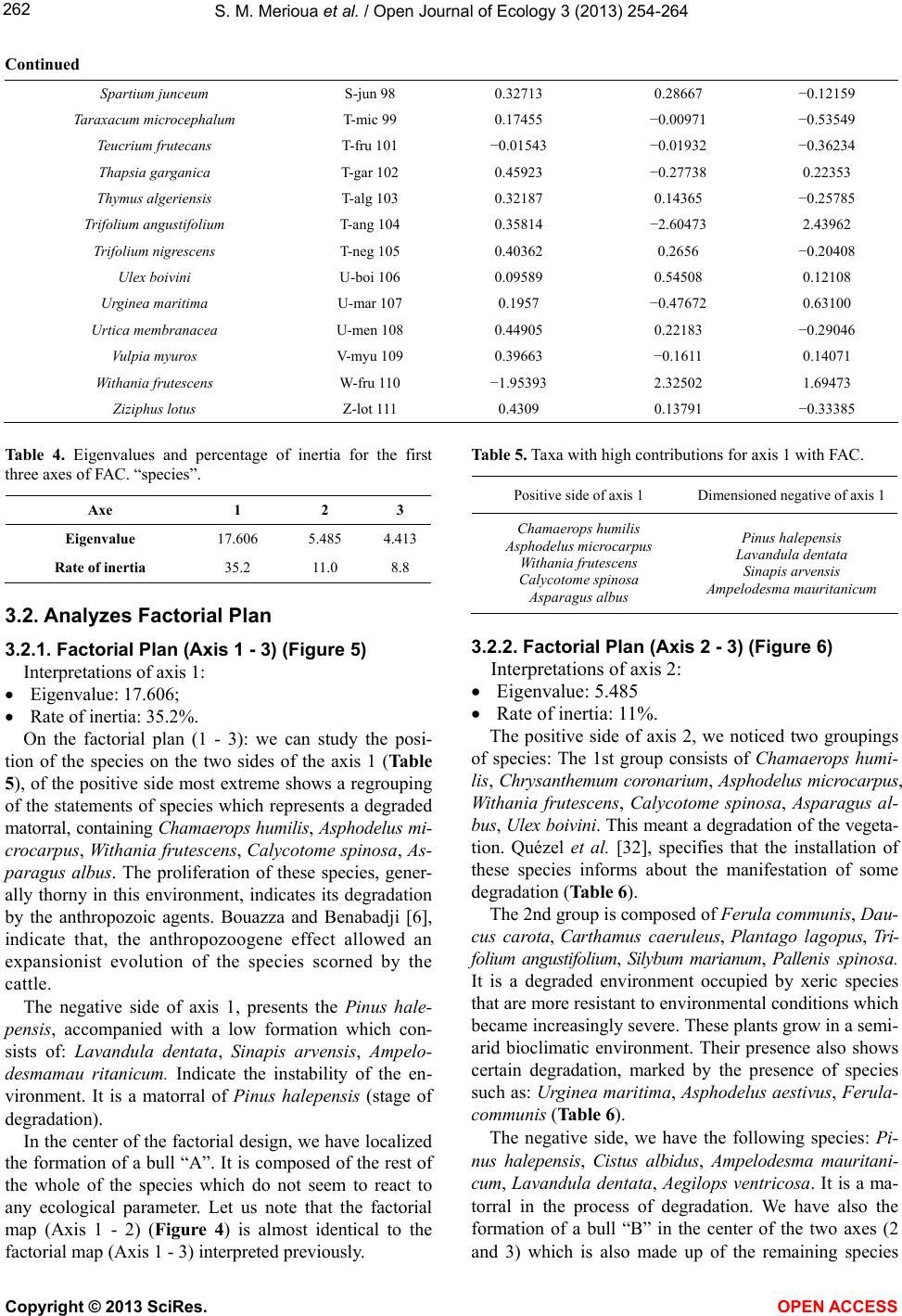 S. M. Merioua et al. / Open Journal of Ecology 3 (2013) 254-264 Copyright © 2013 SciRes. OPEN A CCESS 262 Continued Spartium junceum S-jun 98 0.32713 0.28667 −0.12159 Taraxacum microcephalum T-mic 99 0.17455 −0.00971 −0.53549 Teucrium frutecans T-fru 101 −0.01543 −0.01932 −0.36234 Thapsia garganica T-gar 102 0.45923 −0.27738 0.22353 Thymus algeriensis T-alg 103 0.32187 0.14365 −0.25785 Trifolium angustifolium T-ang 104 0.35814 −2.60473 2.43962 Trifolium nigrescens T-neg 105 0.40362 0.2656 −0.20408 Ulex boivini U-boi 106 0.09589 0.54508 0.12108 Urginea maritima U-mar 107 0.1957 −0.47672 0.63100 Urtica membranacea U-men 108 0.44905 0.22183 −0.29046 Vulpia myuros V-myu 109 0.39663 −0.1611 0.14071 Withania frutescens W-fru 110 −1.95393 2.32502 1.69473 Ziziphus lotus Z-lot 111 0.4309 0.13791 −0.33385 Table 4. Eigenvalues and percentage of inertia for the first three axes of FAC. “species”. Axe 1 2 3 Eigenvalue 17.606 5.485 4.413 Rate of inertia 35.2 11.0 8.8 3.2. Analyzes Factorial Plan 3.2.1. Factorial Plan (Axis 1 - 3) (Figure 5) Interpretations of axis 1: Eigenvalue: 17.606; Rate of inertia: 35.2%. On the factorial plan (1 - 3): we can study the posi- tion of the species on the two sides of the axis 1 (Table 5), of the positive side most extreme shows a regrouping of the statements of species which represents a degraded matorral, containing Chamaerops humilis, Asphodelus mi- crocarpus, Withania fru tescens, Calycotome spinosa, As- paragus albus. The proliferation of these species, gener- ally thorny in this environment, indicates its degradation by the anthropozoic agents. Bouazza and Benabadji [6], indicate that, the anthropozoogene effect allowed an expansionist evolution of the species scorned by the cattle. The negative side of axis 1, presents the Pinus hale- pensis, accompanied with a low formation which con- sists of: Lavandula dentata, Sinapis arvensis, Ampelo- desmamau ritanicum. Indicate the instability of the en- vironment. It is a matorral of Pinus halepensis (stage of degradation). In the center of the factorial design, we have localized the formation of a bull “A”. It is composed of the rest of the whole of the species which do not seem to react to any ecological parameter. Let us note that the factorial map (Axis 1 - 2) (Figure 4) is almost identical to the factorial map (Axis 1 - 3) interpreted previously. Table 5. Taxa with high contributions for axis 1 with FAC. Positive side of axis 1 Dimensioned negative of axis 1 Chamaerops humilis Asphodelus microcarpus Withania frutescens Calycotome spinosa Asparagus albus Pinus halepensis Lavandula dentata Sinapis arvensis Ampelodesma mauritanicum 3.2.2. Factorial Plan (Axis 2 - 3) (Figure 6) Interpretations of axis 2: Eigenvalue: 5.485 Rate of inertia: 11%. The positive side of axis 2, we noticed two groupings of species: The 1st group consists of Chamaerops humi- lis, Chrysanthemum coronarium, Asphodelus microcarpus, Withania frutescens, Calycotome spinosa, Asparagus al- bus, Ulex boivini. This meant a degradation of the vegeta- tion. Quézel et al. [32], specifies that the installation of these species informs about the manifestation of some degradation (Table 6). The 2nd group is composed of Ferula communis, Dau- cus carota, Carthamus caeruleus, Plantago lagopus, Tri- folium angustifolium, Silybum marianum, Pallenis spinosa. It is a degraded environment occupied by xeric species that are more resistant to environmental conditions which became increasingly severe. These plants grow in a semi- arid bioclimatic environment. Their presence also shows certain degradation, marked by the presence of species such as: Urginea maritima, Asphodelus aestivus, Ferula- communis (Table 6). The negative side, we have the following species: Pi- nus halepensis, Cistus albidus, Ampelodesma mauritani- cum, Lavandula dentata, Aegilops ventricosa. It is a ma- torral in the process of degradation. We have also the formation of a bull “B” in the center of the two axes (2 and 3) which is also made up of the remaining species 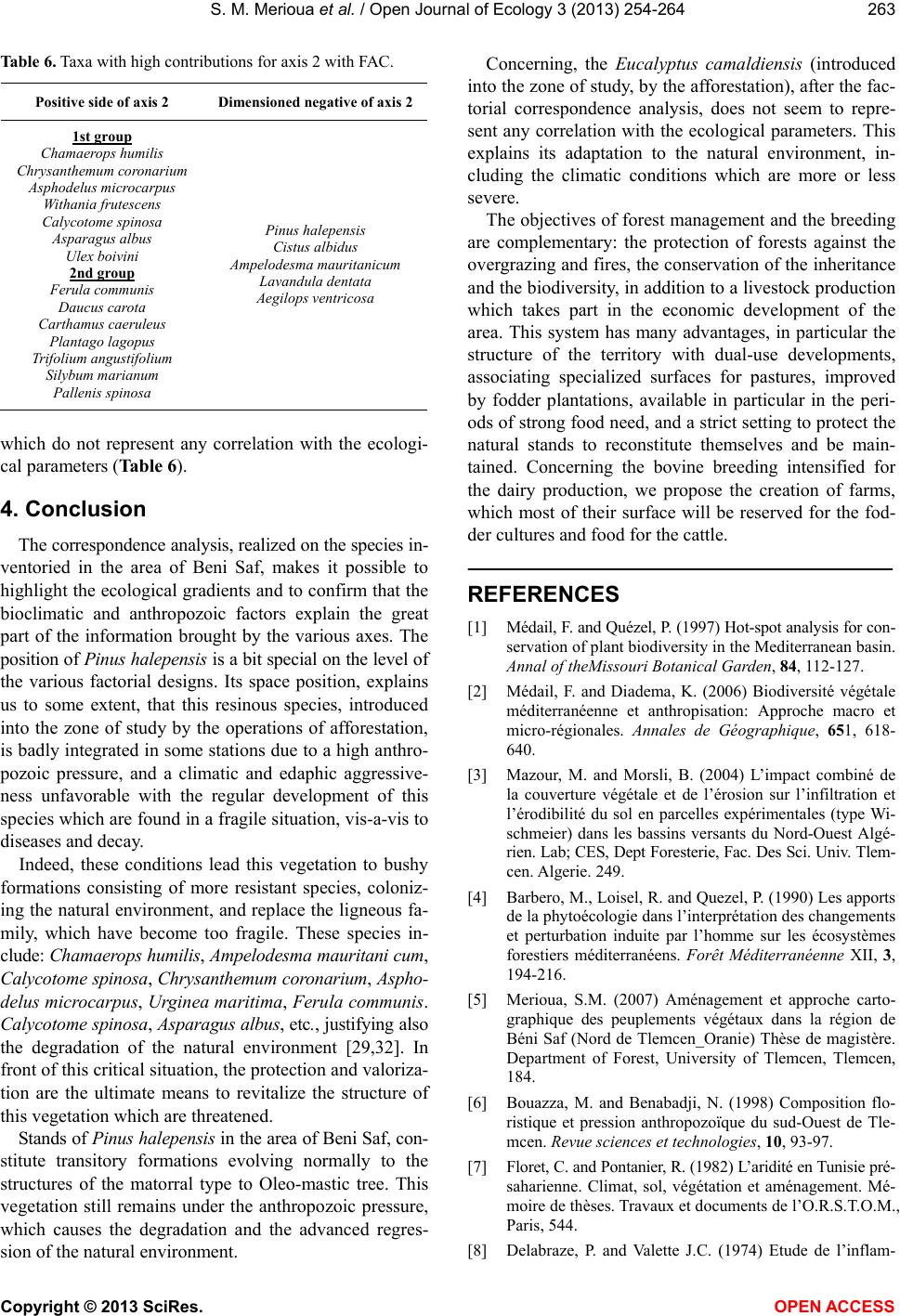 S. M. Merioua et al. / Open Journal of Ecology 3 (2013) 254-264 263 Table 6. Taxa with high contributions for axis 2 with FAC. Positive side of axis 2 Dimensioned negative of axis 2 1st group Chamaerops humilis Chrysanthemum coronarium Asphodelus microcarpus Withania frutescens Calycotome spinosa Asparagus albus Ulex boivini 2nd group Ferula communis Daucus carota Carthamus caeruleus Plantago lagopus Trifolium angustifolium Silybum marianum Pallenis spinosa Pinus halepensis Cistus albidus Ampelodesma mauritanicum Lavandula dentata Aegilops ventricosa which do not represent any correlation with the ecologi- cal parameters (Table 6). 4. Conclusion The correspondence analysis, realized on the species in- ventoried in the area of Beni Saf, makes it possible to highlight the ecological gradients and to confirm that the bioclimatic and anthropozoic factors explain the great part of the information brought by the various axes. The position of Pinus halepensis is a bit special on the level of the various factorial designs. Its space position, explains us to some extent, that this resinous species, introduced into the zone of study by the operations of afforestation, is badly integrated in some stations due to a high anthro- pozoic pressure, and a climatic and edaphic aggressive- ness unfavorable with the regular development of this species which are found in a fragile situation, vis-a-vis to diseases and decay. Indeed, these conditions lead this vegetation to bushy formations consisting of more resistant species, coloniz- ing the natural environment, and replace the ligneous fa- mily, which have become too fragile. These species in- clude: Chamaerops humilis, Ampelodesma mauritani cum, Calycotome spin osa, Chrysanthemum coronarium, Aspho- delus microcarpus, Urginea maritima, Ferula communis. Calycotome spin osa, Asparagus albus, etc., justifying also the degradation of the natural environment [29,32]. In front of this critical situation, the protection and valoriza- tion are the ultimate means to revitalize the structure of this vegetation which are threatened. Stands of Pinus halepensis in the area of Beni Saf, con- stitute transitory formations evolving normally to the structures of the matorral type to Oleo-mastic tree. This vegetation still remains under the anthropozoic pressure, which causes the degradation and the advanced regres- sion of the natural environment. Concerning, the Eucalyptus camaldiensis (introduced into the zone of study, by the afforestation), after the fac- torial correspondence analysis, does not seem to repre- sent any correlation with the ecological parameters. This explains its adaptation to the natural environment, in- cluding the climatic conditions which are more or less severe. The objectives of forest management and the breeding are complementary: the protection of forests against the overgrazing and fires, the conservation of the inheritance and the biodiversity, in addition to a livestock production which takes part in the economic development of the area. This system has many advantages, in particular the structure of the territory with dual-use developments, associating specialized surfaces for pastures, improved by fodder plantations, available in particular in the peri- ods of strong food need, and a strict setting to protect the natural stands to reconstitute themselves and be main- tained. Concerning the bovine breeding intensified for the dairy production, we propose the creation of farms, which most of their surface will be reserved for the fod- der cultures and food for the cattle. REFERENCES [1] Médail, F. and Quézel, P. (1997) Hot-spot analysis for con- servation of plant biodiversity in the Mediterranean basin. Annal of theMissouri Botanical Garden, 84, 112-127. [2] Médail, F. and Diadema, K. (2006) Biodiversité végétale méditerranéenne et anthropisation: Approche macro et micro-régionales. Annales de Géographique, 651, 618- 640. [3] Mazour, M. and Morsli, B. (2004) L’impact combiné de la couverture végétale et de l’érosion sur l’infiltration et l’érodibilité du sol en parcelles expérimentales (type Wi- schmeier) dans les bassins versants du Nord-Ouest Algé- rien. Lab; CES, Dept Foresterie, Fac. Des Sci. Univ. Tlem- cen. Algerie. 249. [4] Barbero, M., Loisel, R. and Quezel, P. (1990) Les apports de la phytoécologie dans l’interprétation des changements et perturbation induite par l’homme sur les écosystèmes forestiers méditerranéens. Forêt Méditerranéenne XII, 3, 194-216. [5] Merioua, S.M. (2007) Aménagement et approche carto- graphique des peuplements végétaux dans la région de Béni Saf (Nord de Tlemcen_Oranie) Thèse de magistère. Department of Forest, University of Tlemcen, Tlemcen, 184. [6] Bouazza, M. and Benabadji, N. (1998) Composition flo- ristique et pression anthropozoïque du sud-Ouest de Tle- mcen. Revue sciences et technologies, 10, 93-97. [7] Floret, C. and Pontanier, R. (1982) L’aridité en Tunisie pré- saharienne. Climat, sol, végétation et aménagement. Mé- moire de thèses. Travaux et documents de l’O.R.S.T.O.M., Paris, 544. [8] Delabraze, P. and Valette J.C. (1974) Etude de l’inflam- Copyright © 2013 SciRes. OPEN A CCESS 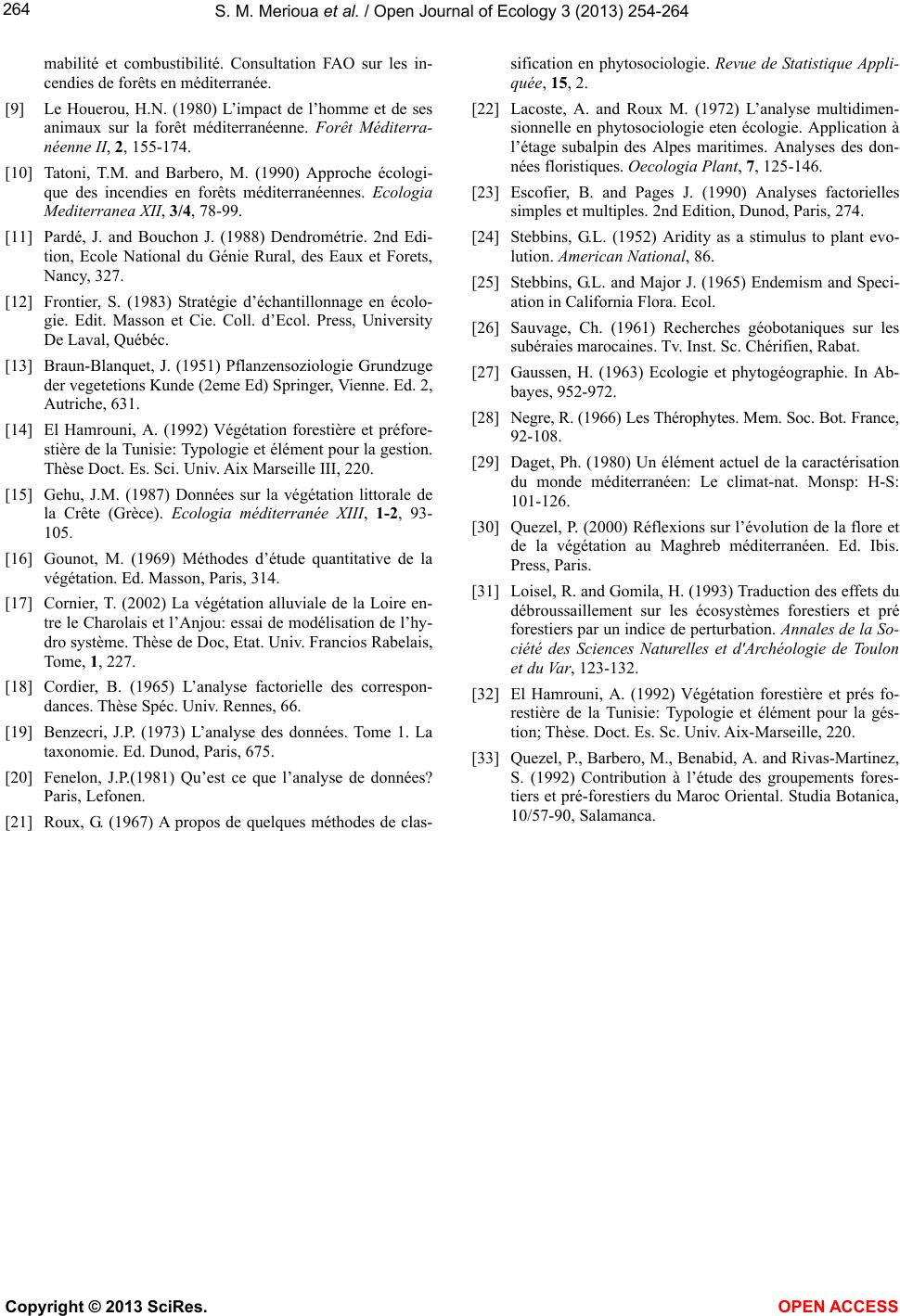 S. M. Merioua et al. / Open Journal of Ecology 3 (2013) 254-264 Copyright © 2013 SciRes. OPEN A CCESS 264 mabilité et combustibilité. Consultation FAO sur les in- cendies de forêts en méditerranée. [9] Le Houerou, H.N. (1980) L’impact de l’homme et de ses animaux sur la forêt méditerranéenne. Forêt Méditerra- néenne II, 2, 155-174. [10] Tatoni, T.M. and Barbero, M. (1990) Approche écologi- que des incendies en forêts méditerranéennes. Ecologia Mediterranea XII, 3/4, 78-99. [11] Pardé, J. and Bouchon J. (1988) Dendrométrie. 2nd Edi- tion, Ecole National du Génie Rural, des Eaux et Forets, Nancy, 327. [12] Frontier, S. (1983) Stratégie d’échantillonnage en écolo- gie. Edit. Masson et Cie. Coll. d’Ecol. Press, University De Laval, Québéc. [13] Braun-Blanquet, J. (1951) Pflanzensoziologie Grundzuge der vegetetions Kunde (2eme Ed) Springer, Vienne. Ed. 2, Autriche, 631. [14] El Hamrouni, A. (1992) Végétation forestière et préfore- stière de la Tunisie: Typologie et élément pour la gestion. Thèse Doct. Es. Sci. Univ. Aix Marseille III, 220. [15] Gehu, J.M. (1987) Données sur la végétation littorale de la Crête (Grèce). Ecologia méditerranée XIII, 1-2, 93- 105. [16] Gounot, M. (1969) Méthodes d’étude quantitative de la végétation. Ed. Masson, Paris, 314. [17] Cornier, T. (2002) La végétation alluviale de la Loire en- tre le Charolais et l’Anjou: essai de modélisation de l’hy- dro système. Thèse de Doc, Etat. Univ. Francios Rabelais, Tome, 1, 227. [18] Cordier, B. (1965) L’analyse factorielle des correspon- dances. Thèse Spéc. Univ. Rennes, 66. [19] Benzecri, J.P. (1973) L’analyse des données. Tome 1. La taxonomie. Ed. Dunod, Paris, 675. [20] Fenelon, J.P.(1981) Qu’est ce que l’analyse de données? Paris, Lefonen. [21] Roux, G. (1967) A propos de quelques méthodes de clas- sification en phytosociologie. Revue de Statistique Appli- quée, 15, 2. [22] Lacoste, A. and Roux M. (1972) L’analyse multidimen- sionnelle en phytosociologie eten écologie. Application à l’étage subalpin des Alpes maritimes. Analyses des don- nées floristiques. Oecologia Plant, 7, 125-146. [23] Escofier, B. and Pages J. (1990) Analyses factorielles simples et multiples. 2nd Edition, Dunod, Paris, 274. [24] Stebbins, G.L. (1952) Aridity as a stimulus to plant evo- lution. American National, 86. [25] Stebbins, G.L. and Major J. (1965) Endemism and Speci- ation in California Flora. Ecol. [26] Sauvage, Ch. (1961) Recherches géobotaniques sur les subéraies marocaines. Tv. Inst. Sc. Chérifien, Rabat. [27] Gaussen, H. (1963) Ecologie et phytogéographie. In Ab- bayes, 952-972. [28] Negre, R. (1966) Les Thérophytes. Mem. Soc. Bot. France, 92-108. [29] Daget, Ph. (1980) Un élément actuel de la caractérisation du monde méditerranéen: Le climat-nat. Monsp: H-S: 101-126. [30] Quezel, P. (2000) Réflexions sur l’évolution de la flore et de la végétation au Maghreb méditerranéen. Ed. Ibis. Press, Paris. [31] Loisel, R. and Gomila, H. (1993) Traduction des effets du débroussaillement sur les écosystèmes forestiers et pré forestiers par un indice de perturbation. Annales de la So- ciété des Sciences Naturelles et d'Archéologie de Toulon et du Var, 123-132. [32] El Hamrouni, A. (1992) Végétation forestière et prés fo- restière de la Tunisie: Typologie et élément pour la gés- tion; Thèse. Doct. Es. Sc. Univ. Aix-Marseille, 220. [33] Quezel, P., Barbero, M., Benabid, A. and Rivas-Martinez, S. (1992) Contribution à l’étude des groupements fores- tiers et pré-forestiers du Maroc Oriental. Studia Botanica, 10/57-90, Salamanca.
|